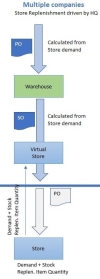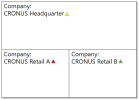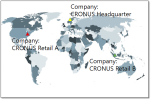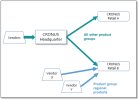


Running Replenishment across multiple companies is a common approach in international operations.
LS Replenishment supports scenarios where purchase replenishment is performed in a central supply chain company (HQ) and the stores reside in sales companies. The sales companies are replenished from the supply chain company.
In this scenario the HQ is in full control of purchase and store replenishment. The HQ company needs to have detailed information about stock and demand of the stores in the sales companies.
To achieve this, replenishment is run in the following steps:
- The Replenishment Item Quantity is calculated in each of the sales companies.
- The Replenishment Item Quantity is calculated in the central supply chain company, and the pre-calculated Replenishment Item Quantity data from the sales companies will be copied to the supply chain company.
The location names need to be in synch between the companies. - With this, the supply chain company is equipped with the sales and demand information in the sales companies, enabling it to:
- calculate purchase orders.
- calculate sales orders to replenish the sales companies.
Since the items need to be transferred between two companies, the system will create Sales Orders instead of Transfer Orders.
For more information see Multi-Company Replenishment.
Key questions / considerations
Questions:
- Which companies are responsible for purchase?
(these are the supply chain companies) - Which companies are replenished from the supply chain companies?
(these are the sales companies) - Is the supply chain company calculating demand for itself and the sales companies?
(this means, that HQ calculates replenishment and sends items to the stores in the sales companies.)- Do the sales companies review the proposal before Sales Orders are created?
- If yes:
- the sales companies need reading access to the supply chain company's Replenishment Journals to review.
- Are the sales companies allowed to change data in the supply chain company's Replenishment Journals?
- If yes:
- the sales companies need write access.
- Who is responsible for the creation of document from Replenishment Journals?
- If yes:
- If yes:
- Do the sales companies review the proposal before Sales Orders are created?
- Are all items in the sales companies replenished from the supply chain company?
- If no:
- What are the exceptions?
- How are those items purchased?
- Manual Purchase Orders?
- If Replenishment should propose these items, see Multiple Company (Store driven)
(this might be a mixed model).
- If no:
- Who is responsible for data maintenance?
- How is data replicated from the supply chain company to the sales companies?
Output
-
A company list which describes the dependencies:
-
Topology drawing:
LS Central setup considerations
Company
LS Central and Replenishment need to be set up in all affected companies.
Locations in sales companies
In this scenario all store locations have to be set up to retrieve the demand information from the local company.
This is done by selecting the value Local Company in the field Data Source on the Location Card page.
For more information see Location.
Locations in HQ company
In this scenario all store locations need to be created in the HQ company, too (with same name), and be set up to retrieve the demand information from the sales company.
This is done by selecting the value Other Company in the field Data Source on the Location Card page.
Furthermore, the sales company name needs to be set up in the field Data Source Company.
For the created Sales Orders, the Customer No. from the Location Card page will be used.
A location with this setup will not calculate stock and demand in the current company, but will copy the calculated values from the company that is set up in the Data Source Company field.
For more information see Location.
Replenishment Calculation
In this scenario the Replenishment calculation takes place in three steps:
- The Replenishment Item Quantity (RIQ) is calculated in the sales companies.
The RIQ is a snapshot of the current stock situation in the stores. - The Replenishment Item Quantity (RIQ) is calculated in the supply chain company (HQ).
The pre-calculated RIQ information from the sales companies is copied to the supply chain company. - The Replenishment Journals for Purchase Orders and Transfer Orders/Sales Orders are calculated in the supply chain company.
It is necessary to ensure that the RIQ calculation in the sales companies is finished before the RIQ calculation starts in the supply chain company.
Intercompany transfer of Sales Orders
The Intercompany transfer of the Sales Orders to the sales company is not part of LS Replenishment and has to be covered by standard Business Central functionality or LS Retail's Franchise module.
Master Data
Since the supply chain company is in full charge of Replenishment, master data (items, replenishment parameters) are usually maintained in this company, too. Data Replication Jobs need to be set up to replicate the data to the sales companies.
Go back to:







